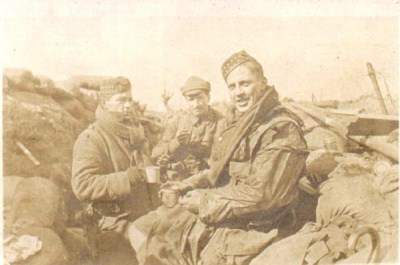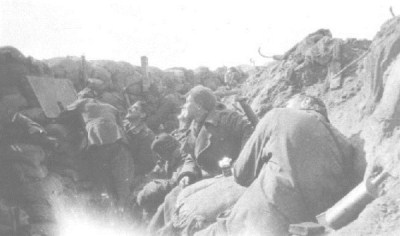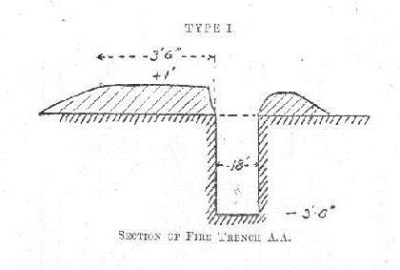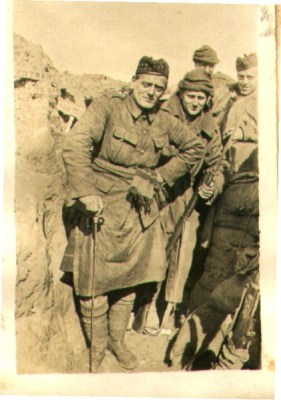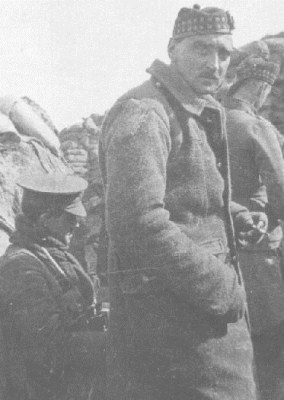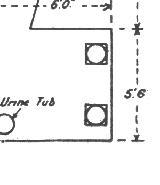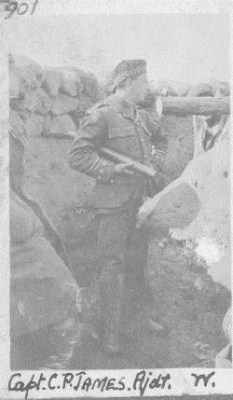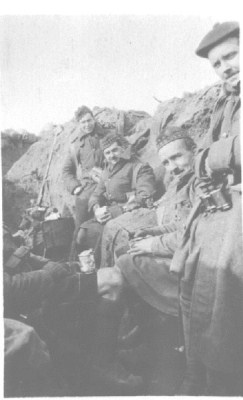Captain Anderson
Captain Anderson Ypres Salient, Spring1915
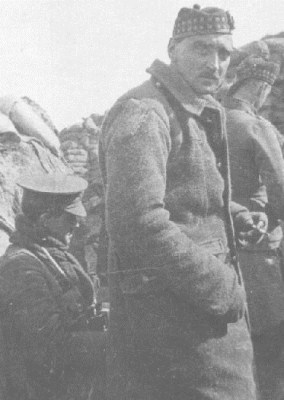 The Liverpool Scottish had arrived in France at the beginning of November 1914, one of the first infantry battalions of the Territorial Force to join the British Expeditionary Force. They arrived in the period almost immediately after the 'Old Contemptibles' of Regular Army (a 'contemptible little army' according to the German Kaiser Wilhelm) had fought alongside the French and the Belgians in a highly mobile campaign which started with the retreat from Mons to the sharp blocking battle at Le Cateau and beyond to the final phase, checking and throwing back the German advance at the River Marne. The Liverpool Scottish joined the 3rd Division of II Corps (a Regular Army formation) and was initially addressed by the Corps Commander, General Sir H. Smith Dorrien, to the effect that, with the co-operation of the Russians, the war would be over by the summer of 1915. The Regimental Historian records that as newly-arrived citizen soldiers of The Scottish 'were surprised to learn that the Staff expected the war to last so long'. They quickly found that they had to relieve hard-pressed regular soldiers in the front lines.
The Liverpool Scottish had arrived in France at the beginning of November 1914, one of the first infantry battalions of the Territorial Force to join the British Expeditionary Force. They arrived in the period almost immediately after the 'Old Contemptibles' of Regular Army (a 'contemptible little army' according to the German Kaiser Wilhelm) had fought alongside the French and the Belgians in a highly mobile campaign which started with the retreat from Mons to the sharp blocking battle at Le Cateau and beyond to the final phase, checking and throwing back the German advance at the River Marne. The Liverpool Scottish joined the 3rd Division of II Corps (a Regular Army formation) and was initially addressed by the Corps Commander, General Sir H. Smith Dorrien, to the effect that, with the co-operation of the Russians, the war would be over by the summer of 1915. The Regimental Historian records that as newly-arrived citizen soldiers of The Scottish 'were surprised to learn that the Staff expected the war to last so long'. They quickly found that they had to relieve hard-pressed regular soldiers in the front lines.
The Photograph is of company commander, Capt AS Anderson.
Sandbags: The photo shows a sandbagged trench. Sandbags were difficult to come by in 1914 so this suggests a later date. Sgt DAB Marples describes how the Germans shot at the sandbags at close range to break them down and reduce the cover that they gave.
Headdress: As the glengarry with diced (chequered) banding is still the headdress of choice but soldiers are still in gloves and greatcoats, this suggests Spring 1915. The soldier to the left in the standard peaked cap is not of The Liverpool Scottish but may be a member of an English battalion coming into or going out of the trenches, an artillery officer or possibly Lt Kidson RAMC. Quite quickly, the stiffening was taken out of the peaked cap as the very flat surface was more easily spotted from the air. Alternatively he might be one of the few Army Service Corps or Medical Corps soldiers attached to the battalion although the binoculars and the location in what appears to be the front line make this unlikely. This particular soldier is well wrapped up against the cold by his scarf; the binoculars that he carries may indicate that he is an officer or a Senior NCO.
Relief: This is the term used to describe the operation when one group of soldiers replaces another group at a particular position. The 'relief' of one battalion by another in the front line is a difficult operation. At the early stages of the war (when there were few communication trenches) it was particularly dangerous. One method was for the new battalion to cross in the open to their new trenches, line up behind and drop in. The outgoing soldiers then climbed out of the back of their trench into the open. This was rather noisy and dangerous for troops in the open but it did give people a chance to find out about the trenches from the previous occupants. An alternative was for the new soldiers to move in at one end while the other soldiers left at the opposite end. There was more protection from the enemy but the new soldiers found out nothing about the new trenches which would almost certainly lead to casualties from snipers.
Link to each page by clicking the images below.
Previous page: Late Spring 1915
Next page: The Latrines

